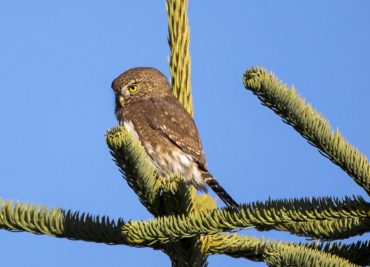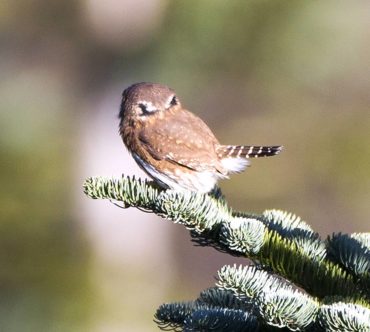
When people think of fierce, predatory birds, the species that come to mind are bald eagles, peregrine falcons and great horned owls. These birds are not picky and will take anything they can grab.
When you see a small owl, the initial reaction may be to say that it’s cute, based on its diminutive size and endearing appearance. After all, small, stuffed owls are everywhere these days.
But if you were to watch a small owl feeding, “cute” is not likely the word that would come to mind. Especially if that bird is a northern pygmy-owl, the smallest owl in Washington and perhaps the most ferocious avian predator in North America.
One of the world’s smallest owls, the northern pygmy-owl measures about 7 inches in length and tips the scale at a mere 2.5 ounces. Like most birds of prey, females are slightly bigger than males. With a round head and round body, the northern pygmy-owl appears larger than it actually is.
The northern pygmy-owl is brown, with white speckles on its head, and has brown streaks on its white chest. The eyes and bill are yellow. Dark spots are found on the back of the head of all pygmy owls. These “false eyes” give predators, such as larger owls, hawks and weasels, the impression that the pint-sized owl is watching them.
There are more than 30 species of pygmy-owls worldwide, six of which are found in North America. Most are found in the American Southwest and Mexico.
The northern pygmy-owl’s range stretches from British Columbia to Central America and east to Colorado and New Mexico. The only species of this genus found in Washington, the northern pygmy-owl is a year-round resident of mixed coniferous and deciduous forests with scattered openings.

Although they are challenging to locate, northern pygmy-owls can be found in suitable habitat throughout West Sound. The forest roads and trails on Green Mountain near Seabeck offer the best chance of finding one. Listen for their tooting calls and look for them at the tops of fir trees or perched on diagonal branches.
Another aid to locating a northern pygmy-owl is to pay attention when a mob of angry songbirds is nearby, which usually indicates the presence of a predator. Following the source of the scolding may lead to the discovery of a pygmy-owl.
Unlike most owls, northern pygmy-owls hunt in the daytime. They often employ a “sit-and-wait” style of attack to feast on songbirds, small rodents and large insects. They are also active at dawn and dusk.
Lacking the facial discs and off-setting ears of nocturnal owls that hunt primarily by sound, northern pygmy-owls rely on their superb eyesight, much like hawks, eagles and falcons.
The northern pygmy-owl may be tiny, but it’s just as aggressive as the much-larger great horned owl. Ounce for ounce, this pint-sized powerhouse can take down prey three times its size, including mourning doves, northern flickers and even small chickens. A fast flyer, this miniature predator is also capable of chasing down prey while in flight.
When the hunting is productive, the northern pygmy-owl caches extra food. It may stuff a future meal into a tree cavity or even impale it on a thorn, like a predatory songbird called shrike. No wonder chickadees aren’t quick to welcome a pygmy-owl to the neighborhood!
Northern pygmy-owls are monogamous and begin courtship in early spring. The male selects a natural tree cavity, preferably one carved by a hairy woodpecker. He then perches at the entrance hole and gives a series of tooting calls in hopes of attracting a mate. The female responds from a distance and the two may sing a duet.
Northern pygmy-owls seldom use artificial nest boxes. The female usually lays three or four eggs. A clutch may have as many as seven eggs in it. Incubation by the female begins after all the eggs have been laid (a unique behavior of North American owls) and lasts for four weeks.
While the female stays on the nest, the male brings her food. The female broods the hatchlings for a week, then guards the nest while the male provides sustenance for the hungry family.
The young are ready to fly when they are 28 days old. Before they are fully independent, fledglings spend their first three or four weeks perched high in the forest canopy, where they beg for food from their parents.
Because northern pygmy-owls are hard to detect, it’s difficult to accurately determine the stability of their population. Since they prefer forest edges, northern pygmy-owls may benefit from logging when large snags with woodpecker holes are left standing.
Although songbirds would disagree, the discovery of a northern pygmy-owl is an awesome find. A ferocious predator, this cute little owl should not be judged by its size.




























Comments